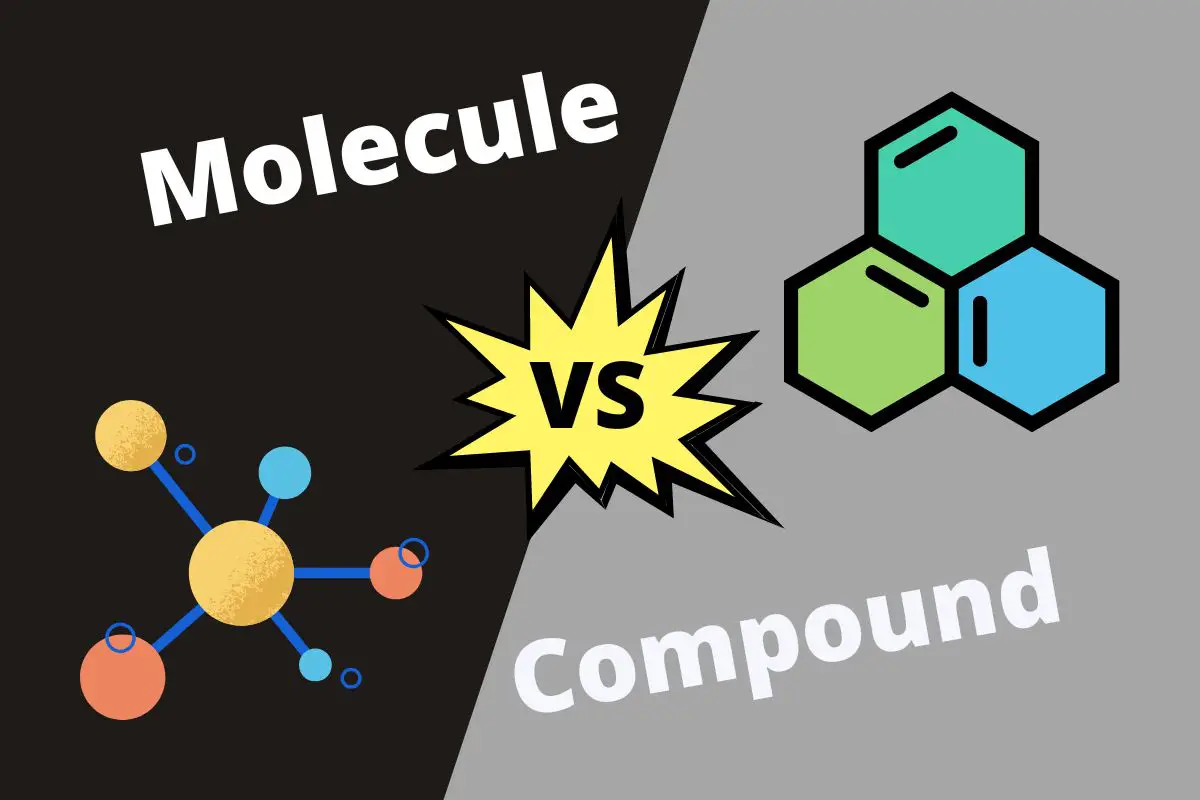The main difference between a molecule and a compound is their composition. While a molecule is a group of two or more atoms, a compound is a group of two or more elements.
In chemistry, the terms molecule and compound are widely used across most concepts and are usually taught using a molecular formula. These terms can overlap because all compounds are molecules, but not all molecules are compounds.
Table of Contents
Molecule vs. Compound
| Molecule | vs | Compound |
| A molecule cannot be seen with the naked eye | Visibility | A compound can only be seen under a microscope |
| Since molecules consist of two or more atoms held by a powerful force, there is no absolute shape | Structure | Compounds are in absolute shape as they consist of different elements which exist in a rigid form |
| It is unstable | Stability | It is stable |
| Ionic and covalent | Types of Chemical Bonds | Ionic, metallic, and covalent |
| Oxygen, dinitrogen, etc. | Examples | Water, sodium chloride, etc. |
What is a Molecule?
The word molecule is derived from the Latin word molecula, which means a unit of mass. Mathematician and chemist James Maxwell defined molecules in 1873.
A molecule combines one or more atoms bonded by chemical bonds (covalent or ionic), forming the smallest entity of a substance that retains the original properties of the substance. Moreover, molecules can again be broken down into simpler substances, i.e., their constituent cations and anions.
There are different types of molecules based on the number of atoms (diatomic, triatomic, and polyatomic) and bonds (covalent and ionic.) Besides, homonuclear, heteronuclear, organic, and inorganic molecules are also present.

Examples of Molecules
Some examples of molecules are
- N2 (nitrogen),
- I2 (iodine)
- O3 (ozone)
- P4 (phosphorus)
- C6H12O6 (glucose, a type of sugar)
- CaO (calcium oxide)
- H2O (water)
- NaCl (table salt)
The molecular weight of a molecule is the sum of all its atomic weights.
Not all molecules are not compounds.
What is a Compound?
A compound, unlike a molecule,is a substance that consists of two or more elements combined in a fixed ratio by mass. When elements combine, a few individual properties of the elements are lost, and the newly formed compound has new characteristics.
Chemical Formula
Compounds are denoted by their chemical formula. A chemical formula is the symbolic representation of the number of atoms combined to form a particular compound.
For example, water is represented as H2O, which means one molecule of water contains two atoms of hydrogen and one atom of oxygen. Compounds are categorized into two types, namely, molecular compounds and salts.
Three Types of Compounds
Based on the number of atoms, there are three types of compounds – diatomic, triatomic, and polyatomic. Moreover, there are organic and inorganic compounds.
Similar to molecules, compounds are further classified based on bonds, covalent and ionic compounds.
All compounds are molecules.
Examples of Compounds
- NaCl (or table salt) has one atom of sodium and one atom of chlorine
- Hydrogen Peroxide (H2O2) has two hydrogen atoms combined with two oxygen atoms

Molecule vs. Compound – Key Differences
Apart from their formation, molecules and compounds have some significant differences. Here are the differences between the two in brief.
Visibility
A molecule cannot be seen with the naked eye because they are formed at the atomic level, while a compound can be seen with the naked eye.
Structure
Structurally, molecules don’t have any definite shape. In contrast, compounds have a definite form.
Meaning
Molecules are groups of two or more atoms bonded by a chemical bond. While compounds are combinations of two or more different elements joined by chemical bonds.
Stability
Molecules can be unstable because they are at the atomic level. However, compounds are always stable because they are in physical form.
Types of Bonds
Molecules are combined by ionic or covalent bonds, while compounds are bonded by ionic, metallic, or covalent bonds.
Examples of Bonds
Examples of molecules include dinitrogen, ozone, oxygen, water, etc. Some examples of compounds include- sodium chloride, calcium carbonate, nitric acid, etc.
Difference Between Molecule and Compound
Molecule and compound are often used interchangeably but have different meanings. Using the correct term is important in science and can create confusion if misused.
Any combination of atoms is a molecule, while a variety of elements mixed in fixed proportions is a compound.
Compounds and molecules have different properties and differ in other aspects. All compounds are molecules, but not all molecules are compounds.
If you’ve enjoyed this article, check out our post comparing elements and compounds.

